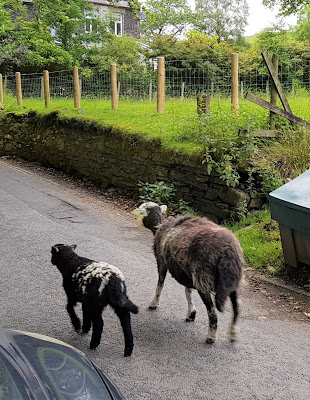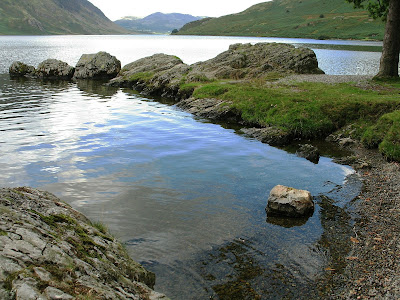It's not only fine walking country (for the fit!). The keen driver can have satisfaction here too. There are for instance several high passes that involve some exciting driving - one or two of them strictly for cars with good, trusted powerplants under the bonnet and brakes in tip-top condition.
In this post, I am going to describe a nice little drive I discovered on my last holiday. At least, I discovered the outward half. The return section, though very driveable, wasn't new to me. It begins and ends at Keswick. It goes west on a minor road over a steep pass to Buttermere, then back on the B5289 via the slightly easier and less steep Honister Pass.
This is the first map section, to help explain the route:
Actually, I set out from the Troutbeck Head Caravan and Motorhome Club site, some miles to the east of Keswick, and turned off the A66 just beyond Keswick, starting my journey proper at Portinscale. The route then heads generally south-west via Swinside, Stair and Birkrigg. It's up and down and bendy, but nothing to what lies ahead.
But first I'd better set the scene. I'd arrived at Troutbeck Head that very afternoon from Scotland, and after a rest had devoured this steak meal:
With that inside me, I was fortified for an evening out in the mountains. The weather was dry but somewhat overcast. I might, or might not, see a good sunset. The thing is, if you want to see a Lake District sunset to its best advantage, you've got to make the effort, and get out into the hills. After a long drive from Fife, another same-day session behind the wheel felt like 'making the effort'!
But as I left Stair and the narrow road began to climb, I felt amply rewarded. Great scenery came into view. Not the most spectacular the Lake District can show, but good enough to stop and admire.
As you can see, there was a breeze, but it wasn't yet uncomfortably cool. Here's the route over the pass and down to Buttermere village:
Note the steepness of the road either side of the pass. I haven't yet 'done' the infamous Hardknott Pass further south, but I'm sure this one must be much the same challenge to a small-engined car. Even Fiona had to work a bit. I gave her a rest when just over the summit.
This was the view straight ahead, towards Buttermere village (and you can just make out the south-eastern end of Crummock Water):
And this was the view sideways from the driver's seat, a few yards further on. The craggy fell in the distance is Wandope.
And so down to Buttermere village, which lies on the neck of land between Buttermere lake and Crummock Water. Sheep take priority on the road, and this ewe and her lamb resolutely refused to yield, and I could only follow slowly them till the passing whims of a sheep's brain led them off the road:
I first saw the Lake District (in person, that is) only in 2006, only eleven years ago, and I haven't yet been to all of it by any means, the chief omissions being the western, south-western and southern parts. It follows then that I haven't seen all of the main lakes. Here's a list of what's in the bag so far, in order of first sight (in the manner of stout Cortez, with wild surmise, silent upon a peak in Darien):
Ullswater 2006
Derwent Water 2006
Buttermere 2006
Crummock Water 2006
Windermere 2013
Thirlmere 2015
Bassenthwaite Lake 2017
Which leaves these remaining big lakes. It will doubtless require elephants, and pith helmets, and harpoons, and machetes, to hack a way through the jungle to them:
Ennerdale Water
Wast Water
Coniston Water
Haweswater
And having ticked all those off, there remain most of the smaller lakes to see, although I can claim credit for seeking out little gems like Blea Tarn. Here it is, as taken in 2013, with the Langdale Pikes on the skyline.
I'm definitely a lake woman rather than a mountain woman (sorry, Mr Wainwright), but there's no denying that mountains enhance a lake's beauty. Which lakes in the Lake District do I presently like the best? With no hesitation, I can say Ullswater, Buttermere and Crummock Water, all of them northern lakes, and all the first ever seen. Ullswater has a vast mysterious stillness, which I hope I've captured in these shots from 2006 and 2013:
More of Crummock Water and Buttermere in a moment. Here's another map, to show the lie of the land from Buttermere village.
I now intended to drive on to Crummock Water and park at its southern end, at the 'B' of B5289 on the map, halfway between Hause Point and Wood House. This is a popular though unofficial place to pull off the road. It's probably hopeless to try parking there during the day, especially in the summer, but in the evening the prospects are better, and I had no trouble on this occasion. I wanted to get out of the car and walk a bit, to a spot last visited in 2006, in another life.
The evening was advancing, and it was growing distinctly dusky. But I felt safe enough. There was a group of people enjoying an open-air barbecue on the immediate shoreline. This was their boat.
They would surely come to my aid if a mad axeman chose to attack! So I walked on confidently. It was still overcast. My photos wouldn't be all that good. I knew that some of them would have to be worked on. Here are two that had their colours changed. Some people like this kind of thing, some don't. I got the effect I wanted, but don't claim it's art.
And now:
Voilà! All done with a smartphone shot and a few tweaks using a Curves tool. Simple peasant folk have been doing this for centuries.
In 2006 there was a short stone jetty on the shore beyond the wood. It was soothing to walk out onto it, and take in the gently lapping water, and the view north-west towards Mellbreak:
Eleven years on, the water was still gently-lapping. I went out onto the jetty. By now it was getting late, and a bit chilly. The new cardigan bought in Pitlochry kept me warm. Looking down, I saw a lake god reflected in the ripples.
There was potentially more to see, and if really keen one could have embarked on an extended walk out to the west. In 2006, with something of a blue afternoon sky, views like this were available:
The barbecue fire on the foreshore was now a glowing red flicker in the fading light. Nobody looked up as I passed. Perhaps they couldn't see me. Just as well I encountered no lurking axemen, then. Turning Fiona around, I drove back through Buttermere village and along the north shore of Buttermere lake. Impressive mountains, including Red Pike, High Stile, High Crag and Haystacks were in view across the lake, off to my right.
Haystacks was of course Alfred Wainwright's favourite mountain, in his view possessing the perfect combination of features (including a particular little unnamed tarn) and wide views from the top, even though it isn't by any means the highest fell in the Lake District. When he died, his ashes were scattered on the top of Haystacks, in accordance with his longstanding wish. It's no coincidence, I feel, that Haystacks and its mountainous neighbours are reserved for Book Seven, the last book, in his famous fell-walking series that took thirteen years to complete. In the handwritten notes written at Christmas 1965, at the end of Book Seven, The Western Fells (I have my own copy, found in a Worthing second-hand bookshop in 2007), he pulls it all together and reveals his opinion on such things as what is the 'best fell' - not an easy thing to do. In the main part of the Book he had much to say about the summit of Haystacks:
...for sheer beauty, variety and interesting detail, for sheer fascination and unique individuality, the summit-area of Haystacks is supreme. This is in fact the best fell-top of all - a place of great charm and fairyland attractiveness. Seen from a distance, these qualities are not suspected; indeed, on the contrary, the appearance of Haystacks is almost repellent when viewed from the higher surrounding peaks: black are its bones and black is its flesh. With its thick covering of heather it is dark and sombre even when the sun sparkles the waters of its many tarns, gloomy and mysterious even under a blue sky. There are fierce crags and rough screes and outcrops that will be grittier still when the author's ashes are scattered here.
Yes, the combination of features, of tarn and tor, of cliff and cove, the labyrinth of corners and recesses, the maze of old sheepwalks and paths, form a design, or lack of design, of singular appeal and absorbing interest. One can forget even a raging toothache on Haystacks.
Elsewhere - I can't find it, but it's somewhere in his books - he asks that after he has gone, future visitors take care when treading around the summit of Haystacks, and not be irritated by any grit that may get into their boots while up there, 'because it may be me'.
That was High Stile (right) and High Crag (left) in my shot above, with Buttermere lake at the bottom. The forbidding black mountain in the centre of the next shot was Haystacks:
Dropping the eyes to the lake itself, this was its south-eastern end. I really liked the fringe of trees on the shoreline here. They had great character.
From here, Fiona faced the winding climb on the B5289 up a valley strewn with boulders moved about then abandoned by the retreating local glacier. It was getting too dark for an effective shot, but I can show this one from 2006:
And so on, up and over the Honister Pass and then down to the villages of Seatoller and Rosthwaite. Another map:
From here, the B5289 was not so adventurous, but it did pass through the bosky woods of Borrowdale and along the shore of pretty Derwent Water. Mind you, the Derwent Water section was frustrating. Lake views were masked by the woods, and there were not many car parks to pull into. And then, suddenly, it was Keswick again and the busy A66.
But something was happening with the sky. The dullness was being pierced by light. I was going to see a sunset after all! On a hunch, I took Fiona up a minor road just to the north of Keswick, and stopped a bit short of Ormathwaite. In the shadow of mighty Skiddaw, so to speak. I shot this:
It looked exactly as if a fire were raging on the foothills of Skiddaw. An odd sunset indeed! But it bore out my assertion that making an effort will bring its reward. I couldn't have seen this from Troutbeck Head.




































